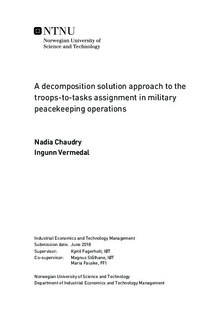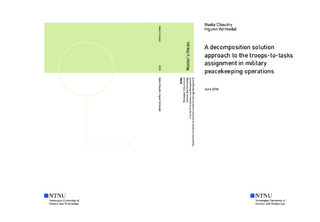| dc.description.abstract | Military peacekeeping operations are becoming increasingly complex, while at the same time facing stricter budgetary restrictions. It is therefore imperative, now more than ever, to have good operation plans that utilize resources efficiently. Currently, the assignment of human resources to military operation tasks is carried out manually. A decision support tool has the potential to greatly improve this process, and simultaneously meet the complexity and financial challenges that exist.
The assignment of human resources to tasks in military peacekeeping operations is defined as a Peacekeeping-Troops-To-Tasks Problem (PTTP). The purpose of a troops-to-tasks analysis in a military peacekeeping operation is to determine which troops are to be assigned to which tasks, at any given time, during a certain planning period. The objective is to find an operation schedule that maximizes the total utility value of completed tasks. What distinguishes the PTTP in this thesis from previous research, is the combination of complex task relations such as connected tasks and direct start requirements, the introduction of long tasks, sleep tasks, rest tasks, and a security task, the possibility of multiple time windows using duplicate tasks, unavailable time periods for resources, and a longer planning horizon. Two exact models are formulated to solve the PTTP: One compact model and one decomposed model. Three travel route generation methods are proposed for the decomposed model, one exact, and two heuristic methods, of which the exact method generates all feasible routes, and the heuristic methods look to only generate the most promising routes.
Computational studies show that even though the decomposed model outperforms the compact model, the PTTP is extensive and complicated to solve when using an exact solution method. The exact decomposed model handles multiple locations well, but high numbers of resources and tasks make it difficult to calculate good solutions in a reasonable amount of time. The heuristic solution methods provide better results for larger instances in the given run time, suggesting that the decomposed model using a heuristic method to generate travel routes has the potential to become a useful decision support tool for military operation planning. | |

